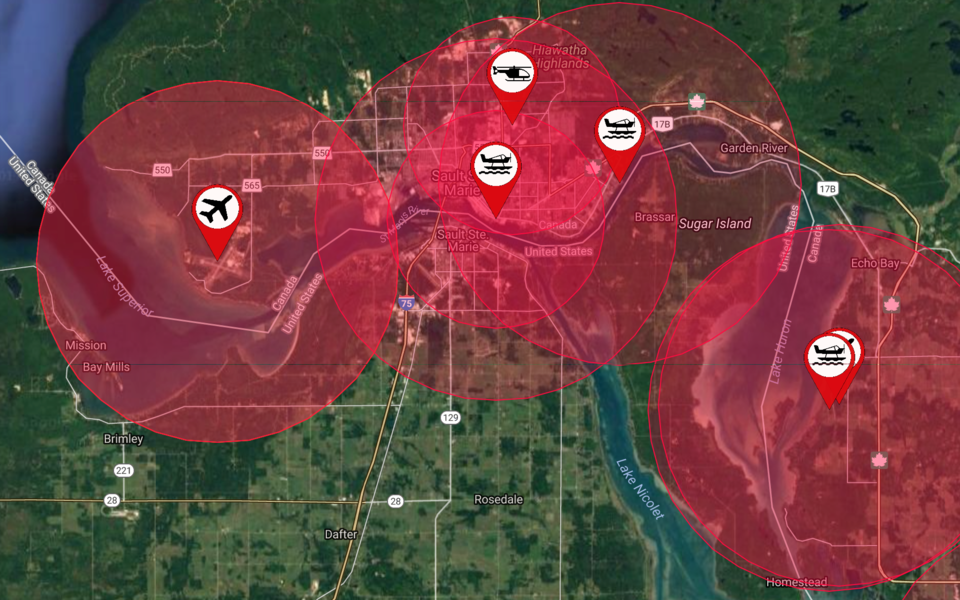Welcome to a no drone zone.
New federal rules that restrict recreational drone users from flying within 75 metres of buildings, vehicles and people effectively eliminates their use within the city for recreational users.
That's on top of a regulation that has been in effect since 2014 that prohibits their use within 9 kilometres of an airport, aerodrome or helipad.
That means there is a nine-kilometre no-drone zone around the Canadian Bushplane Heritage Centre — deemed a seaplane aerodrome by Transport Canada.
When combined with no-fly zones around the Sault Ste. Marie Airport and the helipad at Sault Area Hospital, most of the Sault has been effectively off-limits for years.
The regulations applies only to drones (the technical term is unmanned aerial vehicles or UAVs) weighing 250 grams or more and used for recreational purposes.
However, the Sault Ste. Marie Model Aeronautics Association Canada is exempt from these rules. SooToday will have more on this in an upcoming story.
David G. Coles, a Halifax-based attorney who practices media law as well as civil and business litigation, said the new regulations effectively forbid recreational UAV users from flying in urban areas — with or without a nearby airport.
“There are regulations that you can’t fly (a UAV) within 75 metres of buildings, vehicles and people — you start interpreting that and they have really restricted the use a lot. It’s a profound restriction, as are the height restrictions,” said Coles.
Recreational UAVs are now restricted to fly no higher than 90 metres and may not fly during the night or into clouds.
The new regulations are an example of the law catching up to technology, said Coles.
“Effectively it has been a wild west for amateurs using these things. A series of complaints and concerns are generated, and now the response has been these regulations that, I think, many would view as a bit over the top,” he said.
What hasn’t been sorted, said Coles, is a clear distinction between recreational and commercial use.
“If you fly it on Saturday with your kid in a given area that is quite permissible under the regulations, but you do the same thing Monday — you fly it in exactly the same position — but you do it on the basis you have a contract for the pictures you take. One activity or use is very different than another in terms of licensing requirements, piloting requirements, etc. With the same drone, the same operator, the same everything,” said Coles.
Ron Hell, spokesman for Bearskin Airlines, said the company welcomes the new regulations wholeheartedly.
“Safety is our No. 1 priority, always,” Hell said, noting Bearskin Airlines has not had any close calls with drones as of yet.
“I don’t think we’ve had anything we’d classify as serious, but clearly some airlines have. I think Porter’s had a few close calls recently. There are absolutely higher incidences of drones flying in and around airports’ airspace. It is a potential hazard and it needs to be addressed.
The new regulations stop short of requiring recreational UAVs to be registered with the government, as the Federal Aviation Administration (FAA) has done in the United States.
Coles said enforcement will be a challenge without the requirement for registration of UAVs.
“You order online or go to your big box store and order one of these (UAVs) and then you commit an infraction, let’s say it’s a serious infraction — you fly the thing literally right over a runway. If you simply abandon it, how does law enforcement track you down?” said Coles.
UAV flights cannot interfere with first responders or be flown near forest fire sites and operators must keep them both within line of sight and no further away than 500 metres.
Finally, operators must clearly print their names, address and telephone numbers on their drone.
Const. Dan Chevalier with the Sault Ste. Marie detachment of the RCMP said the local Mounties have long enforced the Aeronautics Act, in situations such as inspections of seaplanes that land at the Bushplane Centre.
Chevalier said UAVs used for commercial purposes must now be registered with Transport Canada.
“With the evolution of (UAVs), especially with cameras on board, you have to take into consideration public safety, people being spied on, what have you,” said Chevalier.
Some new regulations, such as keeping the UAV within sight of the operator at all times, make sense, said Chevalier.
Safety is the primary concern, said Chevalier, and he recommends any questions UAV operators have about the regulations be directed to Transport Canada.
Fines for disobeying the regulations can be as high as $3,000, but Coles notes that may not necessarily be the end of the matter.
“If you fly one of these things such that you do cause harm, that doesn’t preclude either civil liability or — depending what you do in terms of operation — there could be criminal liability,” he said.
— with files from tbnewswatch.com
